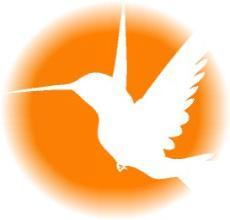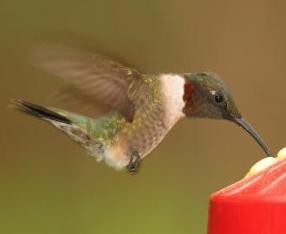
All good things, as they say, must come to an end. Unless you live in California, that usually includes hummingbirds, at least until next spring. Depending on where in North America you live, the fall departure for the southward migration typically occurs between July and November.
Hummingbirds migrate in response to hormonal changes, which are triggered by decreasing length of daylight; nothing you can do will make them stay too long, so it’s not necessary to stop feeding them to force them to go south. On the contrary they will need to fatten up to nearly double normal body weight to survive the journey, and thus appreciate your feeder more than ever up until literally the last minute before they depart.
Maintain at least one feeder for a week or two after seeing your last hummer of the season. Sometimes an individual bird can’t migrate on schedule, due to illness or injury; these late migrants in particular will appreciate having a reliable source of food at a time when few natural flowers are still in bloom. There’s no need to risk your feeder freezing solid, though, so you needn’t get carried away with the concept.
EXCEPTION:
If you live in the southeastern U.S., leaving your feeder out until at least Thanksgiving may attract one of the atypical Rufous or other hummingbirds that are reported more and more often each winter. Some theorize that, while most Rufous migrate north up the west coast in spring then head south down the east slope of the Rockies in fall, a few spend much of the summer traveling eastward across Canada and the northern U.S. and return to Mexico via the eastern seaboard and Gulf states. Others think these birds come directly from the mountain states. There’s a new theory that they migrate normally into Mexico, but dry winter conditions reduce the food supply to the point that some birds are forced to look elsewhere and follow the Gulf coast northeastward into the American South. Much more research is needed, and the truth may involve a combination of these scenarios.

A smaller number of western-species hummingbirds may appear from late August through January in any state east of the Rocky Mountains. Since natural sources of food for these birds are significantly diminished in sub-freezing weather, feeders may contribute greatly to their survival chances. Don’t forget to keep the feeder clean and the syrup fresh, the same as in summer.
Many Anna’s Hummingbirds in coastal California, Oregon, Washington, and Vancouver Island do not migrate at all; and a year-round feeder usually means year-round birds. Farther inland, Anna’s may move seasonally to make best use of local resources; these movements may be more attuned to elevation than to latitude. Several species of hummers spend the winter in modest numbers along the Mexican border. Since winter in most of the southwest offers less natural food than in summer, feeders become important sources of energy to these birds.